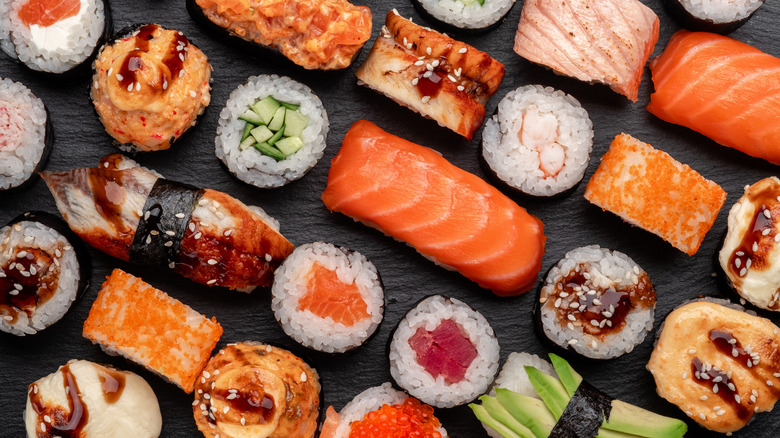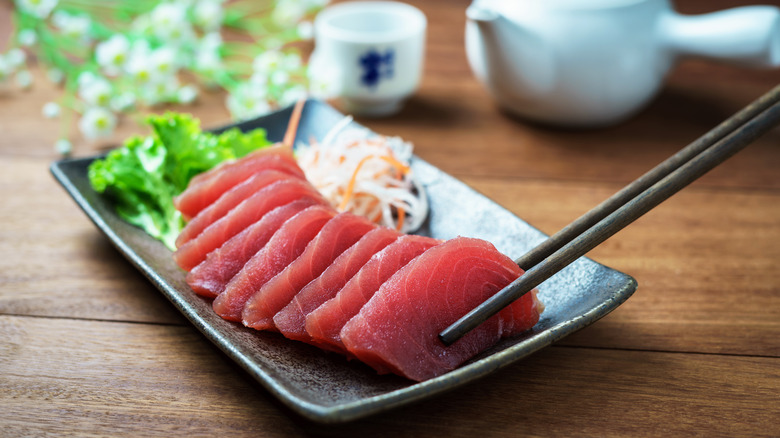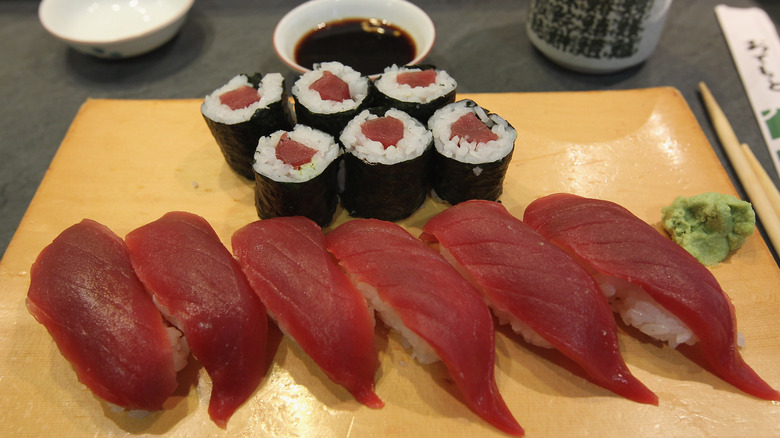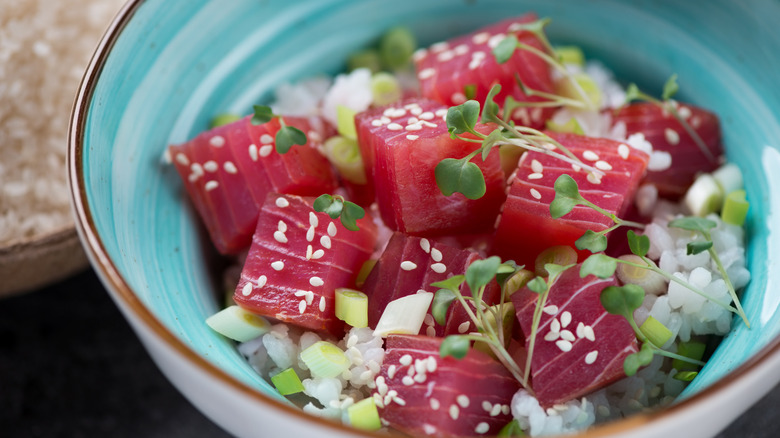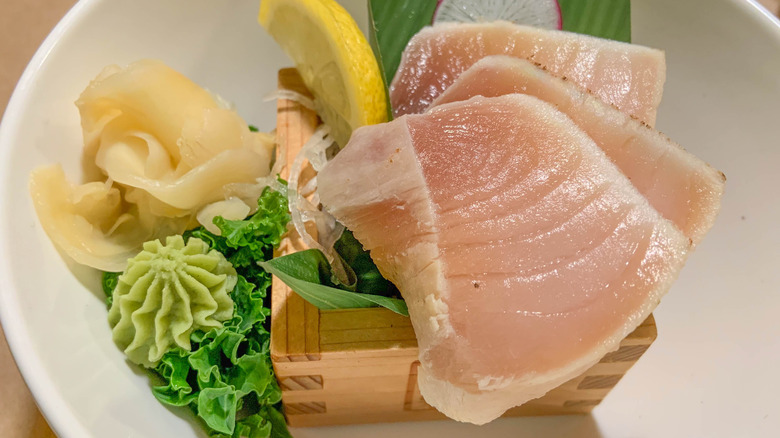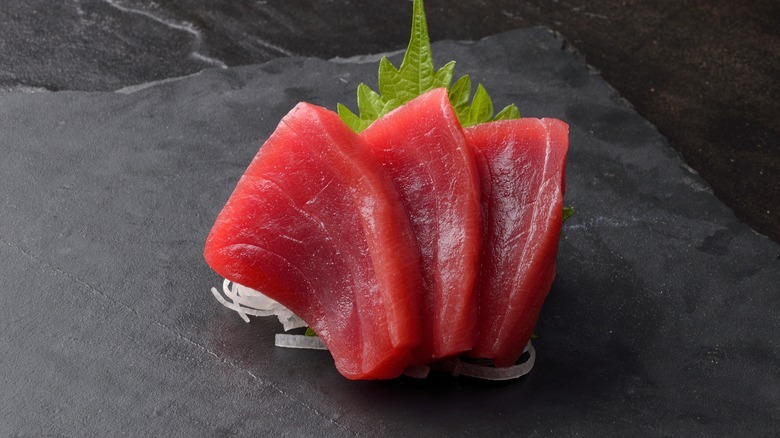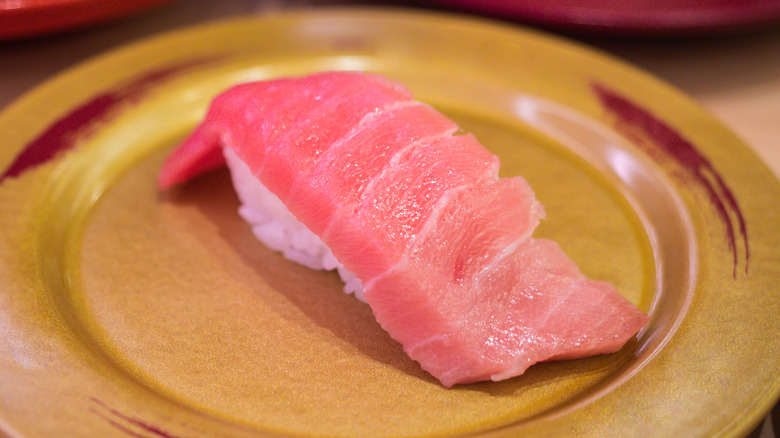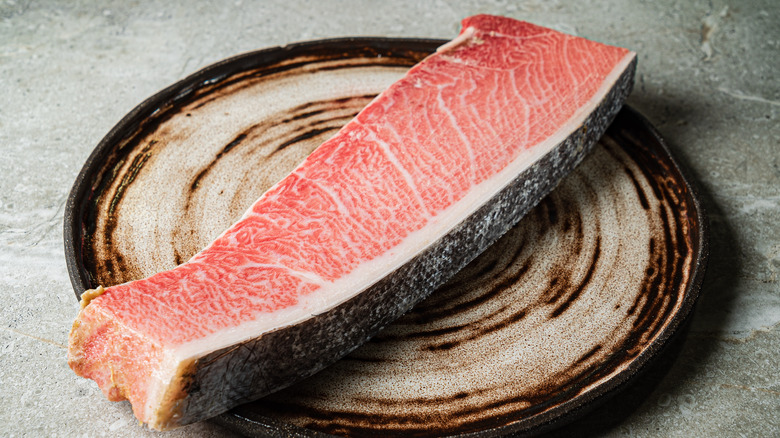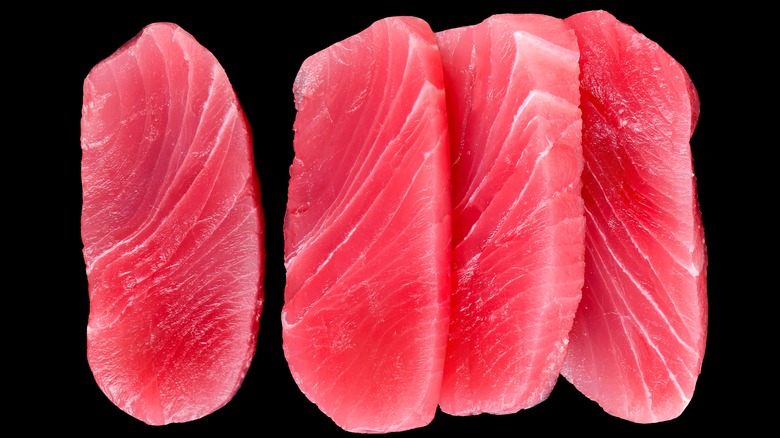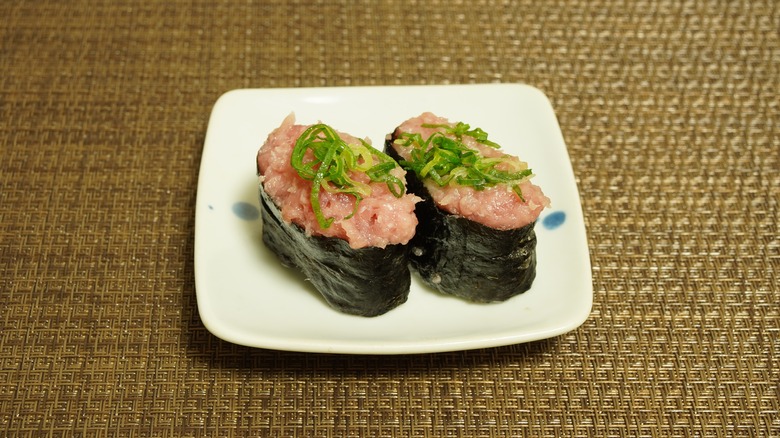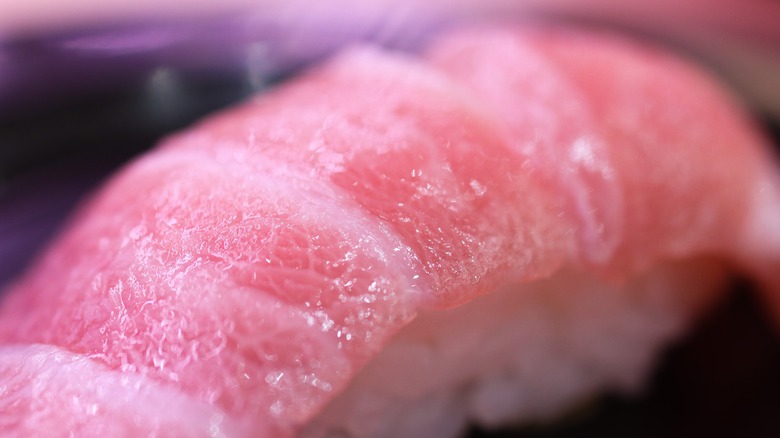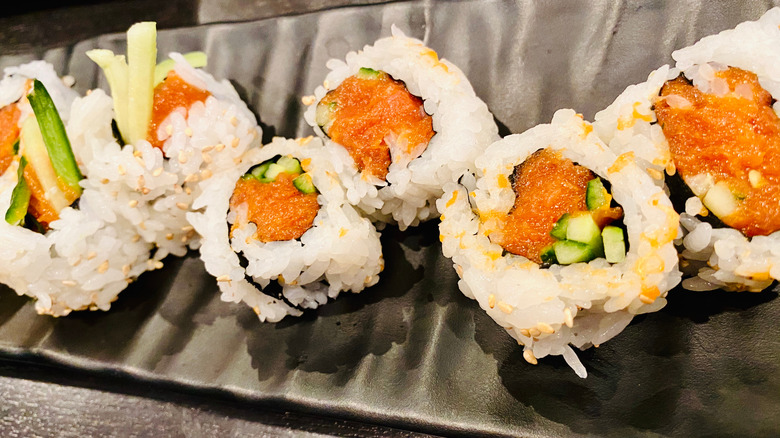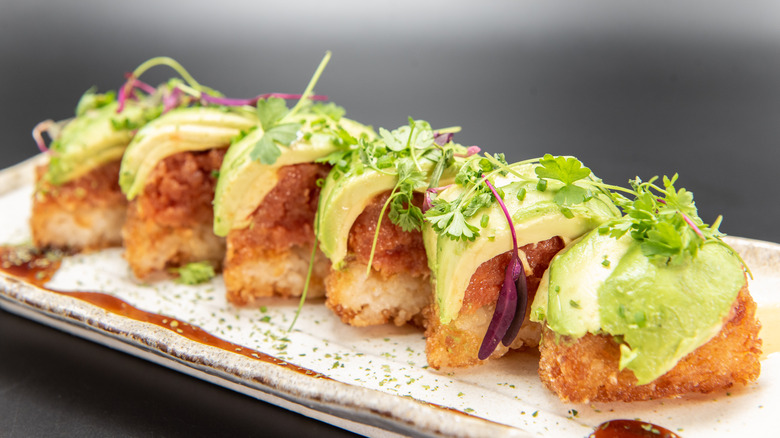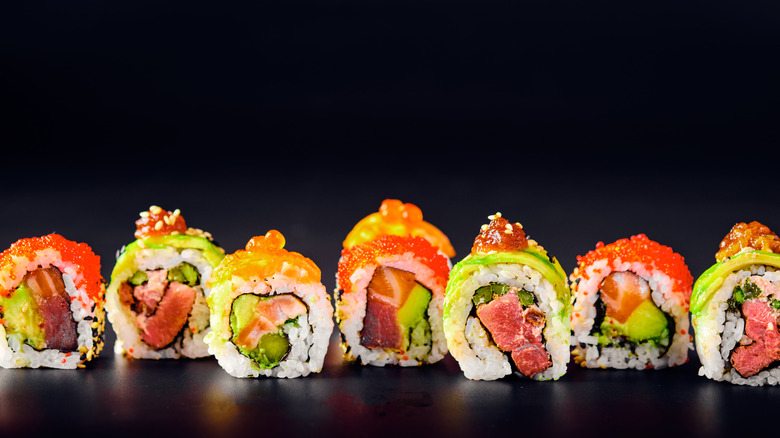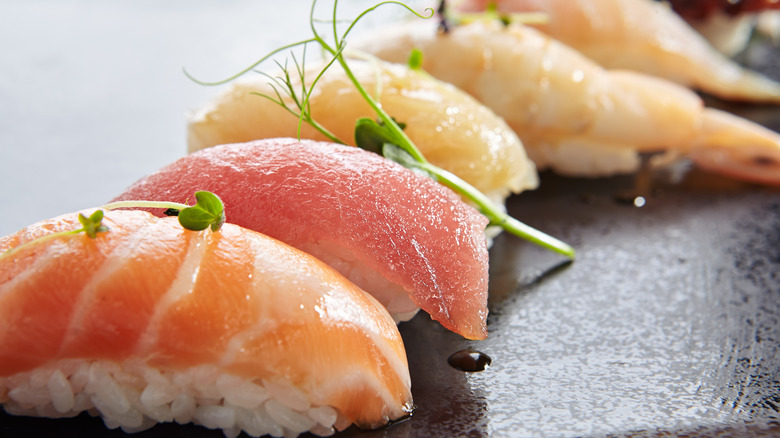14 Tuna Terms You Need To Know When Ordering At A Sushi Restaurant
Ordering sushi can be a somewhat daunting experience, especially if you're not especially familiar with the cuisine. Sometimes the menu descriptions aren't very clear, or they may use vocabulary you don't know. It's tempting to just give up and order a California roll because at least you're familiar with it.
It's normal to feel a little bit uncertain when you're ordering outside of your comfort zone. You shouldn't let your hesitation hold you back, though. Don't let yourself miss out on some truly delicious delicacies! Tuna is one of the most popular components of sushi, and the vocabulary that surrounds it can be confounding. Don't worry: You can easily begin to understand some of the common terminologies that are used when it comes to tuna and its relationship with sushi.
The next time your friends propose a sushi night, you'll be armed with extra knowledge and confidence when you're placing your order. Maybe you'll even introduce your friends to some tasty new options they weren't aware even existed.
1. Sushi vs. sashimi
It's tempting to call all raw fish "sushi" and just be done with it. However, it's important that you know the difference between sushi and sashimi when you are ordering at a sushi restaurant. It's always best to use the proper terminology when you're dealing with food: That way, you'll know exactly what will be arriving at the table.
When you consider sushi, you might imagine the beautiful rolls of rice, fish, and seaweed wrapper. There are countless different variations of sushi rolls, which can incorporate fish, nori, rice, shellfish, vegetables, tofu, and egg. Additionally, sushi rolls might have either raw or cooked components. The rice used in sushi is a special short-grained variety seasoned with vinegar to give it a sticky quality which helps the sushi chefs make the rolls, which are then sliced and artfully presented.
Sashimi, on the other hand, is much more simple in its presentation but no less beautiful. Sashimi is high-quality raw fish that is sliced very thinly and arranged impeccably on your plate. It is usually unadorned, allowing the beauty of the meat and the precision of the chef's knife skills to be the focus of the dish. When you are enjoying sashimi, you are allowing the quality of the seafood to stand out as the star flavor.
2. Maguro
There are many different varieties of tuna that can be used in sushi. Some types you might be familiar with, but others might be new to you. Maguro, or bluefin tuna, is one of the most common sushi tunas that you will experience in a sushi restaurant. Three species of bluefin tuna can be found in various regions of the world: Pacific, Atlantic, and Southern. It is one of the most commonly fished tuna varieties, and the vast majority of the bluefin tuna that is caught is then used in sushi preparation.
Bluefin tuna is the largest tuna species, measuring up to 10 feet in length and weighing up to 1,500 pounds (per WWF). It also fetches astronomical prices at auctions, sometimes costing over $2.75 million (via Japanese Taste). It is highly valued because of its fatty meat and sweet taste, which has made it a much-loved staple on sushi menus around the world.
Maguro, because of its omnipresence in sushi restaurants, is one of the most prized fish in the ocean. This, unfortunately, has led to rampant overfishing. The World Wildlife Federation has included bluefin tuna on its endangered species list for the last decade, warning that the tuna is at the critical juncture of being fished into extinction.
3. Ahi
Ahi is another tuna variety that you will likely come across on a sushi menu. Ahi can refer to either yellowfin tuna or bigeye tuna, which have similar textures and flavors. Ahi tuna is especially popular in Hawaiian cuisine, and it's the tuna you'll most often happen across in poke bowls, sushi's deconstructed, tropical cousin.
Yellowfin and bigeye tuna are smaller than bluefin, coming in at around 7 feet in length and around 450 pounds (via WWF). They're not as critically endangered as bluefin, so they are often fished as a replacement for bluefin during times of scarcity.
It's not uncommon to see ahi served with a sear on the outside while keeping the interior raw. Yellowfin is a firm, lean fish that slices and cubes nicely, while bigeye has a higher fat content that lends a pleasing, creamy mouthfeel. But no matter which version of ahi you get, the flavor tends to be smooth and mild.
4. Shiro maguro
Shiro maguro is better known as albacore tuna with a pale coloring and a sweet, mild flavor. You're probably most familiar with albacore tuna in its canned form. Albacore tuna is versatile enough to be served both raw and cooked. Albacore is one of the smallest species of tuna, and they grow to be around 4 feet long and about 80 pounds in weight (per WWF).
The meat has a soft and creamy quality which makes it ideal for serving raw, and its price point makes it the most affordable variety of tuna (via The Japanese Bar). As such, you will often find shiro serve at conveyor belt style, grab-and-go sushi establishments.
Its mild flavor also makes it exceedingly popular in the U.S. as an introductory sushi and sashimi fish. Albacore is also more prolific and not as endangered as other species of tuna, making it more appealing when considering sustainability and cost.
5. Akami
In addition to the various different types of tuna, it's also important to become familiar with the different cuts of tuna. Just like with beef or pork cuts, depending on where the portions of meat are taken from on the tuna's body, it can yield very different textures and flavors,
Akami is the leanest cut of tuna meat, the top loin of the tuna. It has very little fat marbling, and its flavor remains incredibly mild and not overly fishy. It's firm and dark red, so it's the most visually recognizable cut of tuna when it is used in sushi rolls and sashimi. According to Sushi Modern, akami has the most umami flavor, and it also is chewier since it is a lean cut.
When butchering the tuna, the akami portion is the largest portion that is harvested from the fish, which is why you will find it included in so many tuna sushi recipes. Its flavor also allows it to be complemented with a multitude of vegetables, sauces, and toppings, making it an ideal component in different rolls and sushi presentations.
6. Chῡtoro
Chūtoro sushi is known as the medium fatty cut of tuna (as per Taste Atlas). It's lightly marbled and slightly paler in color than the rich ruby hue of akami. This cut usually comes from the stomach and lower back of the tuna.
It's a combination of muscular and fatty meat on the tuna, and it's an affordable, marbled cut of fish that can be enjoyed. Its texture is more tender than akami due to its higher fat content, and its flavor will be just a bit sweeter.
The price of the chūtoro, a nice middle ground between akami and the more expensive otoro, makes it a very popular choice when dining out at a sushi restaurant. It's an exciting next step from the common akami cut and is a fantastic option for when you're expanding your sushi and sashimi palate.
However, Japancentric cautions that this cut might not be as readily available as others due to the limited amount of chūtoro meat that's found on the average tuna.
7. Otoro
The absolute cream of the crop among tuna cuts is otoro. Otoro is found on the fatty belly of the tuna, and it's the true prize of the fish (via Taste Atlas). This meat is heavily marbled and often served as sashimi or nagiri (a slice of fish on a molded bed of rice). Often otoro will be very briefly seared in order to loosen the fat and make it even more tender.
Otoro tuna is known to melt in your mouth, and it has a very sweet flavor. Otoro is best in the winter when the tuna has put on extra fat to protect it from the cold of the winter sea water. It's also the most costly cut of tuna.
Its popularity really skyrocketed with the advent of refrigeration since its high-fat content would cause the otoro meat to spoil ahead of other cuts (per Japancentric). Once refrigeration became widely available, this flavorful cut became easier to preserve, and it soon took the top spot on many sushi menus.
Its popularity and its limited seasonal availability means that you'll be paying more for your otoro, but you might find the price point worth the unique experience of enjoying a true sushi delicacy.
8. Wakaremi
The wakaremi cut is one of the rarest cuts of meat from the tuna fish (as per Sushi University). Wakaremi is a portion of meat located near the dorsal fin of the tuna. It's a chutoro, or medium fatty, cut, yielding the best of both the umami and sweet flavors of the fish. You might not find wakaremi on the menu of your local sushi joint since it is such a small portion of the fish. It is often given as a gift from the sushi chef to loyal or preferred customers.
If you find yourself the recipient of such a gift from the sushi kitchen, consider yourself a very lucky and prized patron of the restaurant. According to The Japanese Bar, wakaremi is not a cut that is especially well-known at many American sushi establishments. And those that do know of it tend to reserve it since even large tunas yield such a small amount of this meat. So don't take it for granted if you are sent out this very rare delicacy.
9. Negitoro
Negitoro is a delicious sushi roll option you'll find at most restaurants. Its composition is pretty simple: minced tuna and green onion are seasoned with soy sauce, dashi, and mirin and rolled with rice and nori (as per The Japanese Bar).
The tuna meat used in negitoro is scraped from around the bones of the fish. Negitoro rolls utilize a combination of lean and fatty meats from the tuna, which gives them a rounded flavor. The green onions contrast sharply with the sweetness of the tuna meat and the mirin, creating a delightful medley of flavors.
Though negitoro is often seen as a roll, you can also find it served in a bowl with the fish and the seasoned sauce served on top of rice and eaten as a meal that way. However, this is less common, and the negitoro offered at most restaurants is in the roll format.
10. Hoho-niku
Hoho-niku is the cheek meat of the tuna (via Sushi University). It is considered the filet mignon of the tuna world, striking the perfect balance of marbled with delicious fat and having enough muscle to give it a pleasant chewiness.
This cut of meat is located just below the tuna's eye, meaning that there's only a small amount of hoho-niku on each individual tuna. Hoho-niku is eaten as sashimi, and it can also be grilled. Since this cut is so scarce, it typically fetches a higher price if you can find it on sushi menus.
It's typically reserved for connoisseurs and privileged patrons of sushi establishments. It's considered to be one of the best cuts from the entire tuna, so if you're ever able to find it, just know that you'll be in for a true tuna experience that few ever get to enjoy. Savor the most precious cut!
11. Spicy tuna roll
Even if you're a sushi novice, there are a few classic dishes that you likely know by name: California roll, spider roll, dragon roll, and, of course, the spicy tuna roll. The history of the spicy tuna roll is surprisingly recent. Los Angeles, not Tokyo, was the birthplace of the spicy tuna roll. A Japanese chef named Jean Nakayama combined scrapings from the bones of tuna with spicy chili sauce to create what would become one of the most beloved sushi staples.
The spicy meat is usually combined with beautifully julienned cucumbers, then rolled in seasoned sushi rice and nori paper to form a tight roll which is sliced and presented artfully. The beauty of the spicy tuna roll lies in its simplicity; an inventive chef found a way to utilize what would be considered scrap meat and bring a whole new flavor profile to Japanese-American cuisine, which was not known for boasting too many spicy dishes up to that point.
It is worth noting that spicy tuna rolls are considered "Americanized" sushi and not part of the traditional Japanese sushi lineup. So if you're headed to Japan, don't be surprised if you have trouble finding this common U.S. favorite on Japanese menus.
12. Spicy tuna crispy rice
Spicy tuna crispy rice is another fun and delicious raw tuna dish. Similar to a spicy tuna roll, it consists of finely diced tuna combined with mayo and chili crisp. Chili crisp is a fun, zingy condiment that blends chili pepper flakes, onion, garlic, and chili oil. Chili crisp has endless uses, and it pairs delightfully with the flavor of tuna.
The dish is a fun dance with textures: The bed of rice that acts as the vehicle for the tuna is flattened into discs and then flash-fried in oil to become crispy and crunchy on the outside. This is a delightful departure from many sushi rolls, which often just have softer textures. The tuna is laid on top of the crispy rice paddy, and the cool, creamy avocado is either sliced or smashed and used as a topping.
This super popular dish has shown up on menus across the country, and it has been trending on TikTok as an easy make-at-home dish that appeals to sushi beginners and seasoned foodies alike.
13. Other popular tuna sushi rolls
Once you have a basic grasp of tuna at your disposal, you'll feel more confident when you look through the sushi menu at your local restaurant. You're not limited to basic tuna rolls, either. There are lots of different sushi roll options, and tuna often stands out as one of the main proteins featured in sushi.
Firecracker rolls, for example, are a kind of sushi roll that has akami tuna, cream cheese, sliced jalapeño peppers, and spicy mayo. The tuna is again tossed in a spicy chili sauce before being rolled in seasoned sushi rice and nori paper with cooling cream cheese.
Sometimes salmon or additional tuna is added on top of the roll before it is cut into bite-sized servings, and a paper-thin sliver of a jalapeno pepper is often garnished on each piece along with a drizzle of the spicy mayo sauce.
Rainbow rolls are eye-catching because they tend to use a variety of fish (often tuna, salmon, and crab) and brightly colored vegetables to create a color wheel of sushi art. The vibrant roe fish is often used as a crunchy garnish on the outside, along with bright avocado.
14. Watch out for white tuna
One last thing to keep in mind when you are venturing out on your sushi journey is that not everything that is labeled as tuna actually is tuna. Some restaurants will try to pass off cheaper fish as tuna in an effort to cut costs. While this is deeply unethical, it can have other implications as well.
White tuna is one of these culprits. Albacore tuna is often called "white tuna" because its meat tends to be much paler than other varieties of tuna. However, some restaurants will substitute a fish called escolar instead of albacore in these white tuna sushi rolls, sometimes calling it "super white tuna." While albacore has a rosy hue to otherwise pale meat, escolar is snowy, pearl white. According to Global Seafoods, escolar has another name: "Oilfish."
While lots of seafood contain oils and fats, the oils in escolar are called wax-esters, which the human body cannot digest and seeks to expel. So if you end up eating too much escolar, you could end up in pretty uncomfortable digestive distress a few hours later as your body seeks to rid itself of the indigestible oils. So keep an eye out for imposter tuna!
